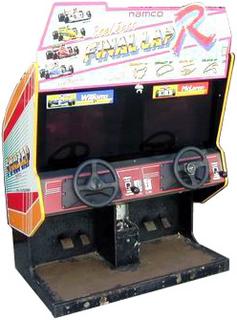
| Final Lap R | |
|---|---|
| Developer(s) | Namco |
| Publisher(s) | Namco |
| Year released | 1993 |
| System(s) | Arcade |
| Preceded by | Final Lap 3 |
| Followed by | Final Lap 2000 |
| Series | Final Lap |
| Japanese title | ファイナルラップR |
|---|---|
| Genre(s) | Racing |
| Players | 1-8 |
| Modes | Single player, multiplayer |
Final Lap R is a racing arcade game that was released by Namco in 1993, and licensed by FOCA to Fuji Television. It is the fourth (and final) game in the company's Final Lap series, and is also the first of just two arcade games from them that ran on their then-new System FL hardware (an Intel I960KB primary microprocessor running up at 20 MHz and a Mitsubishi M37702 sub-microprocessor running at 16.128 MHz, along with a C352 custom sound chip running at 24.192 MHz for audio); much like in all three previous Final Lap games, as well as two other Namco racing titles Four Trax and Suzuka 8 Hours, it allows up to eight players to play simultaneously when four two-player sitdown cabinets are linked together, but this one features four different tracks that are set in Germany, Hungary, Belgium and Brazil (as opposed to Japan, Italy, Monaco and the USA, and England, France, San Marino and Spain). The "R" in the game title literally stands for "Real Spec", "Real Machine", and "Real Course".
For a fourth (and final) time, the players must take up control of either the Williams, McLaren, Ferrari or Benetton cars (the first and second of which have been redesigned for a third time, while the third and fourth ones are new team affiliations and have taken the places of the March and Lotus cars that players 3/7 and 4/8 had driven for the three previous titles), in a Formula One race on one of the four new tracks. In the single player mode, the player's score will yet again be based upon how far his car travels, until the time runs out, or he completes four laps of the decided circuit - and yet again, hitting another car or a billboard (of which there are seven new types in this game) will not cause your car to explode like it would in the two Pole Position games, but it will still send you or that other car spinning off the track. But in the multiplayer mode, up to eight players can yet again race simultaneously when four two-player sit-down cabinets are linked together; this will, yet again, allow for better lap times, as those plain blue CPU-controlled cars (which have also been redesigned for a third time, and explains their new colour) will appear less frequently. The Brazil track, like the American track from the second game and the Spain track from the third game, is the easiest one of the four, and is recommended for the novice players - and once you have mastered it you will be ready to move on to the Belgium track (which is the equivalent of the Monaco and San Marino tracks), followed by the Hungarian one (which is the equivalent of the France and Italy ones). However, the Germany track is the hardest of the four, and is only recommended for the expert players or all players who had managed to master the Japan track in the first two games (and the England track in the third game, which is the Europe equivalent).
-
Title screen.
-
Default best time table.
-
Track selection screen.
-
Namco's arcade flyer.



